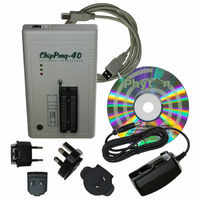CHIPPROG-40 Phyton Inc, CHIPPROG-40 Datasheet - Page 121

CHIPPROG-40
Manufacturer Part Number
CHIPPROG-40
Description
PROGRAMMER STANDALONE 40-DIP
Manufacturer
Phyton Inc
Type
Universal, Stand Aloner
Specifications of CHIPPROG-40
Contents
Programmer, Cables, CD, Power Adapter
Ic Product Type
Programmer, Universal
Ic Interface Type
USB
Features
Embedded Script Language For Automation Of Routine Operations, Splits Files To Multiple Images
Rohs Compliant
Yes
For Use With/related Products
EEPROM, EPROM, FLASH, MCU, NVRAM
Lead Free Status / RoHS Status
Lead free / RoHS Compliant
- Current page: 121 of 182
- Download datasheet (7Mb)
© 2010 Phyton, Inc. Microsystems and Development Tools
layer
in buffer for this layer
in buffer for this layer
ACI_ReallocBuffer()
} ACI_Layer_Params;
BufferNumber
LayerNumber
LayerSizeLow,
LayerSizeHigh
DeviceStartAddrLow,
DeviceStartAddrHigh
DeviceEndAddrLow,
DeviceEndAddrHigh
DeviceBufStartAddrL
ow,
DeviceBufStartAddrH
igh
UnitSize
FixedSize
LayerName
DWORD
DWORD
DWORD
UINT
BOOL
CHAR
CHAR
UINT
UINT
DeviceEndAddrHigh;
DeviceBufStartAddrLow;
DeviceBufStartAddrHigh; // (out) High 32 bits of device memory start address
UnitSize;
FixedSize;
BufferName[64];
LayerName[64];
NumBuffers;
NumLayers;
The ordinal number of the
the ChipProg memory buffers begin from #0.
The ordinal number of the layer in the
is required by the
#0.
Here the function returns the range of the memory
bytes.
Here the function returns the device's start address for the selected
memory
on the device type - usually this value is zero. Do not mix it up with the
start address of a programming operation that can be shifted by a certain
offset value.
Here the function returns the device's end address for the selected memory
layer. This address is the device's property and strictly depends on the
device type. Do not mix it up with the end address of a programming
operation editable in the setup dialog. The selected layer's address range
can be defined as a difference between the end address and the start
address plus 1.
Here the function returns the start address for the selected - usually this
value is zero.
This structure member specifies formats of the data in
the 8-bit devices, 16 - for 16-bit devices and 32 for 32-bit devices.
This flag, if TRUE, disables resizing the memory layer by the
ACI_ReallocBuffer
since the layer #0 is always resizeable the FixedSize is always FALSE
for the layer #0.
The name of the memory buffer as it was defined in the ChipProg interface
or by the
Reserved name of the memory buffer's layer that cannot be changed by the
ACI.DLL user.
layer. This address is the device's property and strictly depends
ACI_CreateBuffer
// (out) High 32 bits of device end address for this
// (out) Low 32 bits of device memory start address
// (out) Size of layer unit, in bits (8, 16 or 32)
// (out) Size of layer cannot be changed with
// (out) Buffer name
// (out) Layer name, cannot be changed
// (out) Total number of currently allocated buffers
// (out) Total number of layers in a buffer
ACI_GetLayer
function. There is one restriction on use of this flag:
memory
Programming Automation via DLL
function. The layer numbers begins from
buffer, content of which is required by
memory
buffer, the content of which
layer's
memory
addresses in
layer: 8 for
121
Related parts for CHIPPROG-40
Image
Part Number
Description
Manufacturer
Datasheet
Request
R

Part Number:
Description:
Diodes (General Purpose, Power, Switching) HIREL
Manufacturer:
Infineon Technologies

Part Number:
Description:
RF Bipolar Small Signal HIREL
Manufacturer:
Infineon Technologies

Part Number:
Description:
RF Bipolar Small Signal HIREL
Manufacturer:
Infineon Technologies

Part Number:
Description:
RF Bipolar Small Signal HIREL
Manufacturer:
Infineon Technologies










